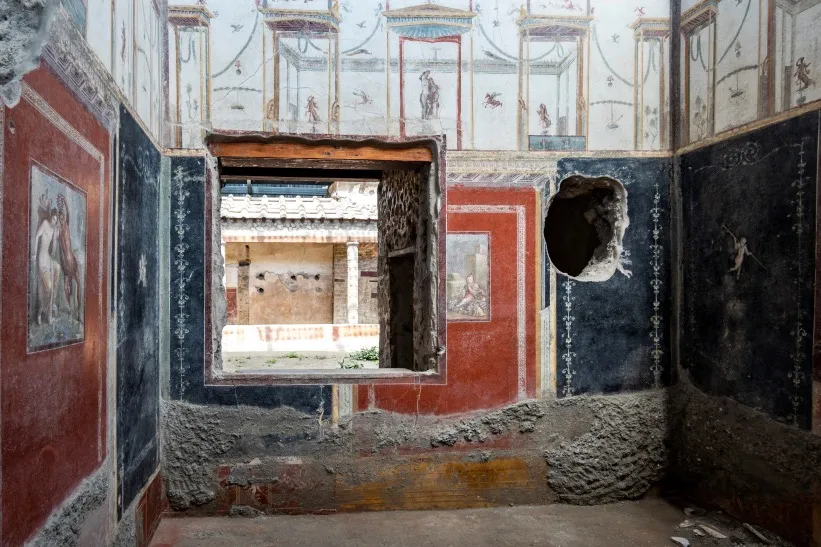
This charcoal sketch of gladiators was drawn from memory, not imagination, researchers say.
Pompeii Archaeological Park
Before Mount Vesuvius erupted in 79 C.E., encasing the ancient city of Pompeii in volcanic ash, local children sketched gladiators fighting to the death on a courtyard wall. The youths’ vivid drawings illustrate the degree of violence to which they were casually exposed on a regular basis.
Archaeologists found the graffiti in the Insula dei Casti Amanti, a cluster of homes and a bakery that recently opened to visitors to the Pompeii Archaeological Park for the first time. Based on the charcoal sketches’ simplicity and naive finesse, researchers have attributed them to children.
Per a statement, one drawing, located about five feet off the floor on the wall of a house, depicts four gladiators: trained fighters who battled beasts and men for ancient Romans’ entertainment. Two of the warriors face off against each other, while the other two appear to be bestiarii—beast fighters—aiming long spears at a pair of wild boars. Off to the right, the artist drew what looks like the head of an eagle.
Due to the simplicity of the line drawings, researchers believe they were made by children. Pompeii Archaeological Park
Child psychology experts from the University of Naples Federico II studied the sketch and concluded that the graffiti artist (or artists) was working not from imagination, but memory, says park director Gabriel Zuchtriegel in the statement.
The children who played in this house’s courtyards and flowerbeds some 2,000 years ago likely attended events at the city’s amphitheater, which—like Rome’s Colosseum—was a venue for bloody fights and hunting spectacles. There, Pompeii’s youth came into contact with an “extreme form of violence,” possibly including the executions of criminals and enslaved people, says Zuchtriegel, per a translation by the Telegraph’s Nick Squires.
The stick figures in the sketch resemble cephalopods, a class of animal that includes octopuses and squids. Their limbs sprout directly from their heads. This characteristic has proved to be an “anthropological constant” in children’s drawings across time, Zuchtriegel adds, and many kids today take a similar approach.
Other rooms in the complex are decorated with fine frescoes. Pompeii Archaeological Park
While researchers suspect a child climbed onto scaffolding to draw this gladiator scene, sketches in a different room were probably drawn at the young artist’s eye level, per the statement. Just one and half feet up the wall of a storeroom for amphorae—tall jars often used to hold oil and wine—illustrations depict three small hands, two people playing with a ball, what looks like a wild boar and two boxers lying on the ground.
Elsewhere in the Insula dei Casti Amanti, archaeologists unearthed the skeletons of a man and woman who died when Mount Vesuvius erupted. The people were likely seeking shelter from the volcanic cloud of hot pumice and ash that killed them. Other rooms in the complex were decorated with frescoes depicting centaurs, sirens and griffins, as well as the gods Apollo, Aphrodite and Dionysus.
Pompeii—which thrived as a port city for more than 600 years before its demise—is a “treasure chest” of archaeological discoveries, says Italian Minister of Culture Gennaro Sangiuliano in the statement. In recent years, excavations have uncovered spectacular frescoes of Helen of Troy, an ancient construction site, erotic art and quarters for enslaved people, among other finds.
This post was originally published on this site be sure to check out more of their content.






